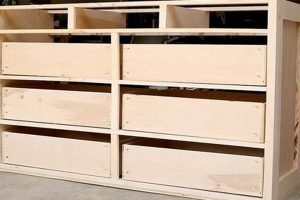Detailed schematics and instructions enabling the construction of a personalized recreational vehicle are essential for successful fabrication. These resources provide specific measurements, material lists, and step-by-step guidance for individuals seeking to build a small, motorized, off-road vehicle from scratch. For example, a detailed set of blueprints might include frame welding diagrams, engine mounting instructions, and steering mechanism assembly guides.
The availability of comprehensive documentation offers numerous advantages, including cost savings through self-sourcing of materials and labor. Building competence in mechanical engineering principles is another significant benefit. Historically, access to such resources was limited, necessitating extensive personal experience. The modern abundance of instructional materials democratizes the building process, allowing more individuals to participate in this hands-on activity.
The following sections will explore various design considerations, safety protocols, and resource options for constructing a personal motorized vehicle. Detailed attention will be given to ensuring structural integrity and adherence to safety standards during the fabrication process. Furthermore, we will discuss methods for selecting appropriate engine types and integrating them effectively within the overall design.
Go Kart Construction Guidance
This section offers essential advice for individuals undertaking the construction of a motorized recreational vehicle from available instructions. Careful consideration of the following points will enhance the safety, durability, and performance of the finished product.
Tip 1: Frame Integrity. Prioritize robust frame construction utilizing high-strength steel. Employ proper welding techniques and ensure all joints are thoroughly inspected for weakness. A compromised frame can lead to catastrophic failure.
Tip 2: Engine Selection. Choose an engine with sufficient power for the intended use, but avoid excessive horsepower that could compromise control. Consider factors such as torque, reliability, and availability of replacement parts.
Tip 3: Steering Geometry. Accurately implement Ackermann steering geometry to minimize tire scrub during turns. Incorrect geometry leads to unpredictable handling and increased tire wear.
Tip 4: Braking System. Install a reliable braking system with adequate stopping power. Disc brakes are preferred over drum brakes for superior performance and heat dissipation.
Tip 5: Safety Features. Integrate essential safety features, including a roll cage, seatbelt, and throttle return spring. These features mitigate risks associated with operation.
Tip 6: Thorough Inspection. Conduct a thorough inspection of all components and systems prior to each use. Address any issues immediately to prevent further damage or potential hazards.
Tip 7: Controlled Environment. Begin operation in a controlled environment, such as a large, open field, to familiarize oneself with the vehicle’s handling characteristics. This allows for safe acclimation and adjustment.
Adhering to these guidelines promotes a safe and rewarding construction experience, culminating in a reliable and enjoyable vehicle. Proper planning and execution are paramount.
The subsequent section will summarize key considerations for ensuring longevity and performance of the assembled vehicle.
1. Frame Integrity
Frame integrity is a paramount consideration when utilizing self-directed plans for go-kart construction. The structural integrity of the frame dictates the vehicle’s ability to withstand operational stresses and impacts, directly impacting driver safety and vehicle longevity.
- Material Selection
The choice of materials significantly influences frame integrity. High-strength steel alloys are commonly recommended due to their favorable strength-to-weight ratio and weldability. Deviating from specified material grades can compromise the frame’s ability to withstand stress, potentially leading to structural failure. The plans often outline specific material specifications, including gauge and tensile strength requirements.
- Welding Techniques
Proper welding techniques are essential for creating strong, durable joints within the frame. Inadequate weld penetration or porosity can weaken the joints, making them susceptible to cracking or failure under stress. Qualified welders or individuals with documented welding proficiency are typically recommended when executing self-directed plans.
- Design Adherence
Strict adherence to the dimensions and specifications outlined in the plans is crucial for maintaining frame integrity. Deviations from the design, such as altering tube diameters or joint locations, can disrupt the intended stress distribution and weaken the overall structure. Verified measurements and careful fabrication practices are necessary.
- Stress Analysis
While not always explicitly included in all sets of self-directed plans, understanding basic stress analysis principles can be beneficial. Areas of high stress concentration, such as suspension mounting points and engine mounts, require particular attention to ensure adequate reinforcement. Incorporating gussets or additional bracing can mitigate stress concentrations and improve overall frame strength.
In summary, frame integrity is a critical aspect of self-directed go-kart construction. Diligent material selection, precise welding techniques, adherence to design specifications, and a basic understanding of stress analysis contribute to a structurally sound frame, ensuring driver safety and vehicle durability. Compromising on any of these facets can have detrimental consequences.
2. Engine Suitability
The selection of an appropriately sized and configured engine is a critical determinant of success when enacting designs for a self-built recreational vehicle. Engine suitability is directly linked to the vehicle’s performance characteristics, safety profile, and overall durability. Incorrect engine selection can lead to compromised handling, reduced longevity, and increased risk of mechanical failure. The power-to-weight ratio must be carefully considered, ensuring that the chosen engine delivers adequate propulsion without overwhelming the vehicle’s structural capabilities. For instance, using an oversized engine can induce excessive stress on the frame, steering components, and braking system, accelerating wear and potentially leading to catastrophic failure.
Different schematics may specify different engine types based on design constraints and intended use. Some designs are optimized for small displacement, low-horsepower engines sourced from lawnmowers or similar small equipment. These are typically geared towards recreational use on relatively flat terrain. Conversely, other designs may accommodate larger, more powerful engines sourced from motorcycles or all-terrain vehicles. These are often intended for more aggressive off-road applications. Regardless of the specific engine type, adherence to the performance parameters outlined in the blueprints is essential. Modifying an existing design to accommodate a significantly different engine can necessitate extensive structural modifications, potentially voiding any safety considerations factored into the original design.
In conclusion, engine suitability represents a crucial consideration in the successful implementation of self-directed fabrication processes. Careful matching of engine characteristics to the vehicle’s design parameters is essential for ensuring safe, reliable, and enjoyable operation. Neglecting this aspect can lead to suboptimal performance, increased risk of component failure, and potentially hazardous operating conditions. Thus, thorough research and careful adherence to the documentation are imperative for successful project completion.
3. Steering Accuracy
Steering accuracy is a fundamental attribute of any vehicle, critically impacting its maneuverability, stability, and overall safety. When constructing a go-kart from self-directed documentation, meticulous attention to steering geometry and component selection is paramount to achieving the desired handling characteristics.
- Ackermann Geometry Implementation
Ackermann geometry is a design principle intended to mitigate tire scrub during turns by angling the inner wheel more sharply than the outer wheel. Precise implementation of Ackermann steering geometry, as specified in the documentation, is crucial for achieving predictable and responsive steering behavior. Incorrectly implemented geometry can lead to increased tire wear, reduced cornering grip, and potentially unstable handling. Drawings often provide precise measurements for steering arm angles and pivot point locations to ensure accurate Ackermann implementation.
- Steering Linkage Precision
The accuracy and robustness of the steering linkage directly affect the transmission of steering inputs from the driver to the wheels. Looseness, excessive play, or improper alignment within the linkage can introduce slop and imprecision into the steering system. Self-directed building requires the precise assembly of tie rods, steering knuckles, and other linkage components, as per the designs dimensional specifications. Any deviation can compromise steering response and reduce overall control.
- Wheel Alignment Parameters
Camber, caster, and toe are critical wheel alignment parameters that influence steering characteristics and tire wear. Blueprints should provide specifications for these parameters, and the builder is responsible for ensuring accurate alignment during the construction phase. Improper wheel alignment can result in erratic handling, excessive tire wear, and increased steering effort. The use of specialized alignment tools may be necessary to achieve the specified parameters.
- Component Quality and Selection
The quality of steering components, such as the steering wheel, steering shaft, and steering box or rack, significantly impacts steering accuracy and durability. Using low-quality or mismatched components can compromise steering feel, reduce steering precision, and increase the risk of mechanical failure. It is prudent to select components that meet or exceed the specifications outlined within the plans, and to ensure compatibility between all elements of the steering system.
The achievement of optimal steering accuracy during self-directed go-kart assembly demands meticulous attention to detail, precise fabrication techniques, and the selection of high-quality components. Deviation from prescribed specifications can negatively impact the vehicle’s handling characteristics, potentially compromising safety and diminishing the overall driving experience. Therefore, rigorous adherence to the provided documentation and a commitment to quality craftsmanship are essential for a successful outcome.
4. Braking effectiveness
Braking effectiveness constitutes a critical safety component in any go-kart design, and its integration within self-directed construction presents unique challenges and responsibilities. Blueprints and instructions for amateur-built go-karts must address braking system selection, installation, and maintenance with meticulous detail. The capacity of the braking system to rapidly and reliably decelerate the vehicle is paramount for preventing accidents and ensuring operator safety. Insufficient braking power, system malfunctions, or improper installation can lead to loss of control, collisions, and potential injury. Therefore, adequate braking capability is not merely a desirable feature; it is an essential element of responsible go-kart construction.
The relationship between self-directed designs and braking capability necessitates a comprehensive understanding of brake system types, hydraulic principles, and proper component selection. Documentation must specify appropriate brake system configurations, considering factors such as vehicle weight, expected operating speeds, and intended terrain. Examples include specifying disc brake systems for higher-performance applications requiring enhanced heat dissipation, or simpler drum brake systems for lower-speed recreational use. Detailed instructions must guide the builder through the process of mounting brake calipers, routing brake lines, and bleeding the system to ensure optimal hydraulic performance. Real-world examples of braking failures due to incorrect installation highlight the significance of adherence to these specifications.
Ultimately, braking effectiveness is inextricably linked to the quality of the designs and the competence of the builder. While instructions provide a framework, the builder bears the responsibility for ensuring that the chosen components are suitable, that installation procedures are followed meticulously, and that regular maintenance is performed to uphold system integrity. The practical significance of this understanding cannot be overstated; it directly translates to the safety and well-being of the go-kart operator and any individuals in the vicinity.
5. Safety integration
Safety integration represents a critical, non-negotiable element within self-directed go-kart construction. Adherence to safety protocols, incorporated through design and implemented during fabrication, directly influences the likelihood of injury or fatality during operation. Blueprint specifications often detail mandatory safety features, such as roll cages, seatbelts, and properly designed braking systems. Failure to incorporate these elements compromises the structural integrity of the vehicle and increases the risk of severe harm in the event of a collision or rollover. The absence of a roll cage, for example, can result in fatal head injuries during a rollover incident. Similarly, the lack of a functional seatbelt system may lead to ejection from the vehicle, exposing the operator to significant risk of impact with the surrounding environment.
The effective incorporation of safety features necessitates a comprehensive understanding of engineering principles and adherence to established safety standards. Manuals and schematics provide a starting point, but builders must exercise due diligence in ensuring that all safety components are correctly installed and functioning as intended. For instance, a roll cage must be constructed from appropriately sized and rated steel tubing, welded using approved techniques to ensure structural strength. Seatbelts must be securely anchored to the frame and properly adjusted to fit the operator. Braking systems must be thoroughly tested to verify adequate stopping power and reliable operation. Moreover, builders must consider additional safety measures, such as installing a kill switch to rapidly shut down the engine in an emergency and implementing appropriate shielding to protect the operator from hot engine components.
In summary, safety integration is not an optional add-on but an intrinsic component of responsible go-kart construction. Prioritizing safety throughout the design and build process minimizes risk and promotes a safer operating environment. While detailed plans offer guidance, the builder bears ultimate responsibility for ensuring that all safety features are implemented correctly and effectively. Neglecting safety integration exposes operators to unacceptable risks and undermines the purpose of the recreational activity.
6. Assembly precision
The successful realization of recreational vehicle designs depends critically on assembly precision. The accuracy with which each component is fabricated and joined dictates the structural integrity, performance, and safety of the final product. Drawings provide detailed specifications, but their utility hinges on the builder’s ability to translate those specifications into a physical reality with minimal deviation. Inadequate attention to detail during assembly can negate even the most meticulously crafted blueprints. For example, misaligned steering components resulting from inaccurate assembly lead to erratic handling, compromising vehicle control and driver safety. Similarly, poorly secured engine mounts can cause excessive vibration, accelerating wear and potentially leading to engine failure. The significance of this understanding is that even the most theoretically sound plans become ineffective without exacting implementation.
Further illustrating the importance of assembly precision, consider the fabrication of the frame. A frame assembled with inaccurately cut or welded members may exhibit torsional weakness, diminishing handling performance and increasing susceptibility to damage from impacts. Blueprint tolerances are carefully calculated to ensure proper load distribution and structural stability. Deviating from these tolerances, even by seemingly small amounts, can cumulatively weaken the frame’s overall integrity. Another practical application lies in the assembly of the braking system. Imprecise assembly of brake lines or caliper mounts can lead to fluid leaks, reduced braking effectiveness, and ultimately, a compromised safety system. Therefore, assembly precision transcends mere aesthetics; it directly influences the functional reliability and safety of the completed vehicle.
In conclusion, assembly precision is a non-negotiable prerequisite for the successful execution of amateur vehicle construction. Diligent adherence to dimensional specifications, meticulous welding techniques, and careful component alignment are essential for translating theoretical into practical. The challenges lie in the potential for human error and the difficulty of achieving consistent accuracy without specialized equipment. However, the benefits of prioritizing assembly precision enhanced safety, improved performance, and increased longevity far outweigh the costs in terms of time and effort. Furthermore, this understanding is linked to the broader theme of responsible building practices, emphasizing the builder’s commitment to quality and safety.
Frequently Asked Questions
This section addresses common inquiries regarding the process of building a go-kart from available blueprints. It seeks to clarify essential aspects, encompassing design considerations, safety protocols, and resource allocation.
Question 1: Are schematics universally compatible with all available materials?
No, schematics are typically designed for specific materials and dimensions. Substituting alternative materials without careful analysis can compromise structural integrity.
Question 2: What level of mechanical expertise is required for successful construction?
A foundational understanding of mechanical principles, welding techniques, and basic fabrication is generally necessary. Prior experience is advantageous.
Question 3: How critical is adherence to dimensional specifications outlined in the drawings?
Adherence is paramount. Deviations from specified dimensions can negatively impact handling characteristics, stability, and overall safety.
Question 4: What safety equipment is considered mandatory during operation?
At a minimum, a roll cage, seatbelt, and appropriate protective gear (helmet, gloves) are essential for mitigating risk of injury.
Question 5: Can engine size be freely modified without affecting the design?
Engine selection must align with frame capacity and load distribution. Exceeding design parameters can result in structural failure.
Question 6: What resources are available for troubleshooting construction challenges?
Online forums, technical documentation, and experienced builders represent potential sources of assistance and guidance.
In summary, successful go-kart construction hinges on meticulous planning, adherence to specifications, and a thorough understanding of mechanical principles. Safety should be the foremost consideration throughout the entire process.
The subsequent segment will explore common pitfalls and challenges encountered during the self-directed building process.
Conclusion
This exploration of blueprints has underscored the multifaceted nature of this undertaking. Key areas highlighted include the critical importance of frame integrity, the careful selection of suitable engines, the necessity for precise steering geometry, the implementation of effective braking systems, the thorough integration of safety features, and the vital role of assembly precision. Each element contributes significantly to the overall safety, performance, and longevity of the constructed vehicle.
Individuals considering embarking on a project should recognize the inherent responsibilities associated with amateur vehicle construction. Prioritizing safety, meticulous adherence to instructions, and a comprehensive understanding of mechanical principles are crucial for a successful and safe outcome. The information presented serves as a foundation for informed decision-making and responsible building practices. Diligence and a commitment to quality craftsmanship are paramount.



![Best DIY Slide In Truck Camper Plans [Easy Build Guide] The DIY Hub: Creative Crafts, Repairs & Life Hacks Best DIY Slide In Truck Camper Plans [Easy Build Guide] | The DIY Hub: Creative Crafts, Repairs & Life Hacks](https://craftingdiycenter.com/wp-content/uploads/2025/07/th-1432-300x200.jpg)



